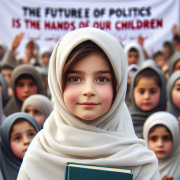With the ongoing auction of mineral resources, Afghanistan’s economy is anticipated to experience substantial growth, driven by increased GDP and employment rates. The development of critical infrastructure, including roads and railways, is likely to enhance connectivity and accessibility within Afghanistan, contributing to economic efficiency. The influx of foreign specialists may lead to a transfer of skills and knowledge, particularly in emerging technological sectors, reshaping the educational landscape.
Note: All images are generated by AI.
Predicting the future of a nation involves analyzing various factors, each playing a crucial role in shaping its trajectory. Let’s delve into the potential future of Afghanistan in 2040, considering economic trends, political stability, and technological advancements.
Political Stability: The Bedrock of Afghanistan’s Future
The political landscape in Afghanistan serves as a cornerstone for the nation’s future trajectory. The role of the Taliban in consolidating power and fostering stability is pivotal in shaping the country’s prospects.
 A stable political climate is a catalyst for various positive outcomes that can profoundly influence Afghanistan’s development. Should the Taliban successfully consolidate power, Afghanistan will become more diplomatically attractive. The international community tends to engage more readily with politically stable nations. A cohesive and empowered government can engage in productive diplomatic relations, opening avenues for cooperation and collaboration on the global stage.
A stable political climate is a catalyst for various positive outcomes that can profoundly influence Afghanistan’s development. Should the Taliban successfully consolidate power, Afghanistan will become more diplomatically attractive. The international community tends to engage more readily with politically stable nations. A cohesive and empowered government can engage in productive diplomatic relations, opening avenues for cooperation and collaboration on the global stage.
Political stability is a magnet for foreign investors seeking secure environments for their investments and acts as a catalyst for sustained economic growth. Political stability enhances Afghanistan’s position in international collaborations. Stable governance is more likely to result in positive relationships with neighboring countries and the broader international community.
Economic Trends in Afghanistan Under Taliban Governance
As we peer into the future of Afghanistan in 2040 under Taliban governance, economic trends take center stage, playing a pivotal role in shaping the nation’s trajectory. Here’s a closer look at the potential economic landscape:
The auctioning of Afghanistan’s abundant mineral resources, including gold, iron, copper, lapis lazuli, and other raw materials, is expected to be a driving force behind the country’s economic growth. International partnerships and investments in mining operations could contribute significantly to Afghanistan’s revenue streams. With a focus on harnessing the nation’s natural resources, Afghanistan might experience economic diversification. New industries, particularly in mining and manufacturing, could emerge, reducing the country’s historical reliance on agriculture.

Economy of Afghanistan in future (AI Generated)
Investment in infrastructure projects, such as roads, railways, and energy facilities, could enhance connectivity within Afghanistan and its neighboring regions. Improved infrastructure might facilitate trade and transportation, contributing to economic efficiency and development.
Despite the economic potential, challenges may arise. International recognition of the Taliban government could hinge on their ability to address issues such as human rights, women’s rights, and political inclusivity. Resilience in the face of these challenges will be crucial for Afghanistan’s sustained economic growth.
Technological Imperatives for Afghanistan: A Call for Educational and Technological Investment
In charting Afghanistan’s path toward a prosperous future, there exists a critical need for substantial investment in education and technology. Presently, the existing policies exhibit a stagnation that, if persisting, may impede the nation’s progress. Recognizing the transformative power of educational and technological advancements, a strategic shift is imperative, particularly in the spheres of education infrastructure, research and development (R&D), and gender inclusivity.
The foundation for technological progress lies in a robust educational system. Afghanistan must redirect its focus towards substantial improvements in the education infrastructure, ensuring that schools and universities are adequately equipped to foster learning. The modernization of educational institutions is paramount, facilitating an environment conducive to embracing cutting-edge technologies. Investment in research and development is the bedrock of technological innovation. Afghanistan’s policies must prioritize and fund R&D initiatives that span various sectors, including science, technology, healthcare, mining, and agriculture. Establishing research centers and fostering collaboration with international institutions can propel the nation to the forefront of technological advancements.
An inclusive education policy is non-negotiable. Afghanistan must break barriers and provide equal opportunities for education to all, irrespective of gender. A pivotal aspect is ensuring that girls are not only allowed to study but are actively encouraged and promoted in all fields. Gender inclusivity in education fuels diversity of thought, essential for a thriving technological landscape. To accelerate progress, Afghanistan should actively seek collaborative partnerships with international educational and technological institutions. Such partnerships can facilitate knowledge exchange, provide access to expertise, and contribute to the development of a skilled workforce ready to harness the benefits of advancing technologies.

Now, strategic investments in education and technology can redefine its future. A commitment to improving education infrastructure, fostering research and development, and promoting inclusivity will not only propel the nation into the technological age but also ensure sustainable and equitable progress for all its citizens.
Conclusion: A Bright Future Ahead, Afghanistan’s Journey to Stability and Progress
Afghanistan stands at a pivotal crossroads where the convergence of political stability, economic foresight, and technological imperatives holds the key to its future. The ongoing auction of mineral resources and potential changes under Taliban governance present opportunities for transformative growth. Political stability is crucial for attracting foreign investment and fostering international collaborations, while economic diversification and technological advancements offer pathways to prosperity. The call for substantial investment in education, inclusive policies, and collaborative partnerships reflects a commitment to shaping a resilient and thriving Afghanistan. As the nation navigates this complex journey, overcoming challenges and making strategic investments will be essential in defining a narrative of progress and promise, positioning Afghanistan as a beacon of resilience and prosperity on the global stage.



 A stable political climate is a catalyst for various positive outcomes that can profoundly influence Afghanistan’s development. Should the Taliban successfully consolidate power, Afghanistan will become more diplomatically attractive. The international community tends to engage more readily with politically stable nations. A cohesive and empowered government can engage in productive diplomatic relations, opening avenues for cooperation and collaboration on the global stage.
A stable political climate is a catalyst for various positive outcomes that can profoundly influence Afghanistan’s development. Should the Taliban successfully consolidate power, Afghanistan will become more diplomatically attractive. The international community tends to engage more readily with politically stable nations. A cohesive and empowered government can engage in productive diplomatic relations, opening avenues for cooperation and collaboration on the global stage.